
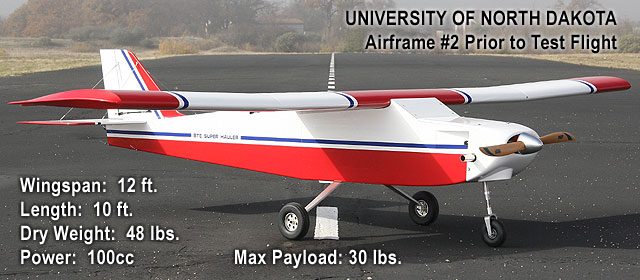
Three BTE Super Haulers were built at BTE in 2008 for the University of North Dakota. Engines and R/C
equipment were installed in two of them, and the aircraft were test flown by Bruce Tharpe before delivery.
The third airframe will serve as a backup, if needed.
The engineering students there have converted their first Super Hauler into a true
UAS (unmanned aerial system) by equipping it with an autopilot and various payloads. At least one graduate
student has earned his PhD using data collected by his payload flown in the Super Hauler UAS. This simple, all-wood
design is ideal for the University setting because it is easy to fly, easy to maintain, and perhaps most important,
easy to modify to suit a variety of experiments.
|
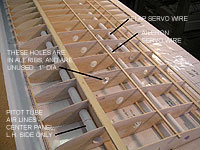 WING CENTER SECTION
WING CENTER SECTION
The Super Hauler wing is built in three sections. The beefy center section, shown here, spans six feet.
The two outer panels, each spanning three feet, are removeable for easy transport. In this airframe, a
pitot tube is incorporated in the wing joint on the left-hand side. Construction is traditional model
airplane - balsa ribs and sheeting; hardwood main spars.
|
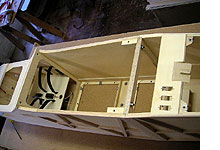 FUSELAGE FRONT
FUSELAGE FRONT
The fuselage is constructed in two sections, front and rear. The sections are bolted together and may
be disassembled for transport, if necessary. Here you can see the massive, uninterrupted payload bay.
The inside dimensions are 11.5" width x 13" height x 22" length. Max payload weight is
30 lbs. Changing payloads should have little effect on the balance point of the aircraft.
Primary access is from the top - the wing removes with two bolts.
This airframe also has two hatches on the bottom.
|
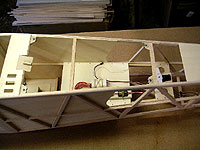 FUSELAGE REAR
FUSELAGE REAR
Again, you can see the traditional balsa construction. The rear fuselage section features a large hatch for
access to the radio equipment and autopilot. Removable plywood plates make this area easy to re-configure
or modify. Servo wires for the wing are routed up and over the wing trailing edge, so connections can be
made quickly and easily after assembly.
|
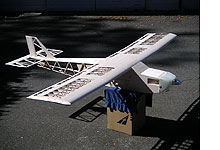 ASSEMBLED AIRFRAME PRIOR TO COVERING
ASSEMBLED AIRFRAME PRIOR TO COVERING
This is also known as a "bare bones" shot. The Super Hauler design is based on BTE's popular
Super Flyin' King, which is a rugged, aerobatic sport R/C model. The Super Hauler is optomized for
lifting with a more-cambered airfoil, 12" more wingspan, and longer flaps. The fuselage was lengthened
24" for greater stability, and widened for greater payload capacity. The Super Hauler is not available
as a kit - they are built to order at BTE.
|
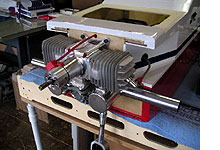 ENGINE INSTALLATION
ENGINE INSTALLATION
The UND aircraft are all be powered by the ultra-reliable Desert Aircraft DA-100. The mufflers were
custom made for this aircraft to exhaust on each side. Large cooling ducts were designed into the
airframe to keep the engine temps low. Two Du-Bro 50 oz. fuel tanks are installed, and providing
over an hour of duration. A large nose hatch and "windshield" hatch allow easy access to the tanks and
engine equipment.
|
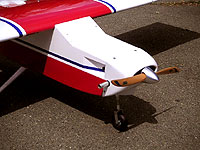 FINISHED AIRCRAFT - NOSE
FINISHED AIRCRAFT - NOSE
A sparkling Tru-Turn spinner and custom fiberglass cowling help streamline the bulky front end.
The 27" diameter Vess propeller provides tons of thrust, and flies the aircraft at cruise speeds
around 60-70 mph. The rugged, spring-loaded nose gear strut was manufactured by Sierra Precision.
|
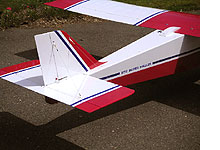 FINISHED AIRCRAFT - TAIL
FINISHED AIRCRAFT - TAIL
The covering is all Monokote, chosen for its light weight and easy repairability. The tail unit - fin, rudder,
stabilizer, and elevator - is removeable with five bolts for transportation ease. The elevator servos are
located under the stabilizer; each servo drives one half of the split elevator. Adjustable tail brace wires
are used for tail strength and rigidity.
|
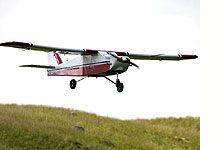 IN FLIGHT
IN FLIGHT
You can see here that the UND students
have installed a pitot tube and several antennas on this Super Hauler. Surprisingly, the aircraft are
part of the Electrical Engineering Department, not Aerospace. The students focus is on developing various
payloads. The Super Hauler, in this case, is just a robust tool for them to test their projects in the air.
|
|
|



